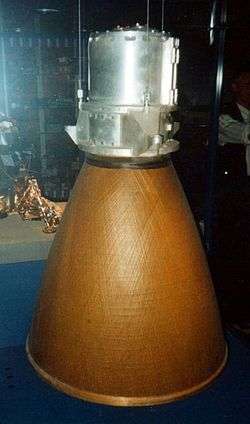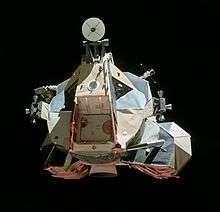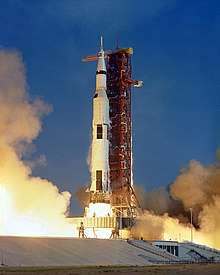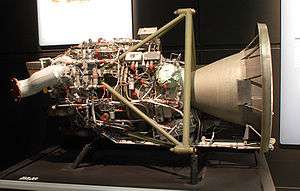Ascent propulsion system
The ascent propulsion system (APS) or lunar module ascent engine (LMAE) is a fixed-thrust hypergolic rocket engine developed by Bell Aerosystems for use in the Apollo lunar module ascent stage. It used Aerozine 50 fuel, and N
2O
4 oxidizer. Rocketdyne provided the injector system, at the request of NASA, when Bell could not solve combustion instability problems.[1]
 Apollo LM ascent engine | |
| Country of origin | United States |
|---|---|
| Date | 1964–72 |
| Manufacturer | Bell Aircraft / Rocketdyne |
| Application | Lunar Ascent Stage/Spacecraft propulsion |
| Predecessor | Bell 8247 |
| Successor | RS-18 |
| Status | Retired |
| Liquid-fuel engine | |
| Propellant | N 2O 4 / Aerozine 50 |
| Cycle | Pressure-fed |
| Configuration | |
| Chamber | 1 |
| Performance | |
| Thrust (vac.) | 3,500 pounds-force (16 kN) |
| Thrust-to-weight ratio | 19.44 |
| Isp (vac.) | 311 seconds (3.05 km/s) |
| Dimensions | |
| Length | 47 inches (120 cm) |
| Diameter | 34 inches (86 cm) |
| Dry weight | 180 pounds (82 kg) |
| Used in | |
| Lunar module as ascent engine | |

Origins
The LMAE traces its origin to the earlier Bell Aerosystems engines (8096, 8247) used in the RM-81 Agena, the American rocket upper stage and satellite support bus developed by Lockheed initially for the canceled WS-117L reconnaissance satellite program.[2] The Agena served as an upper stage for several defense, intelligence, and exploration programs: SAMOS-E, SAMOS-F (ELINT Ferret) and MIDAS (Missile Defense Alarm System) military early-warning satellites, Corona photo intelligence program, and the Ranger and Lunar Orbiter lunar probes.
The Lockheed Agena target vehicle using the Bell 8247 engine was qualified for 15 restarts for NASA's Project Gemini.[3]
A total of 365 Agena rockets were launched by NASA and the US Air Force between February 28, 1959 and the last Agena D launched on 12 February 1987, configured as the upper stage of a Titan 34B.[4][5]
Development
During the spring of 1963, Grumman hired Bell to develop the lunar module ascent engine, on the assumption that Bell's experience in development of the Air Force Agena engine would be transferable to the lunar module requirements. Grumman placed heavy emphasis upon high reliability through simplicity of design, and the ascent engine emerged as the least complicated of the three main engines in the Apollo space vehicle, including the LM descent and CSM service propulsion system engines.
Embodying a pressure-fed fuel system using hypergolic (self-igniting) propellants, the ascent engine was fixed-thrust and nongimbaled, capable of lifting the ascent stage off the Moon or aborting a landing if necessary.[6]
The engine developed about 3,500 pounds-force (16 kN) of thrust, which produced a velocity of 2,000 meters per second from lunar launch, to LOR, and CM docking.[1] It weighed 180 pounds (81.6 kg), with a length of 47 inches (119.4 cm) and diameter of 34 inches (86.4 cm).[7]
RS-18 Engine
Rocketdyne brought the lunar module ascent engine out of its 36-year retirement, now designated as RS-18, and reconfigured this non-throttleable hypergolic engine to use LOX/methane for NASA Exploration Systems Architecture Study (ESAS) engine testing in 2008.[8]
References
- "LM Ascent Propulsion". Encyclopedia Astronautica. Retrieved June 7, 2012.
- Jacob Neufeld; George M. Watson, Jr. & David Chenoweth (1997). "Technology and the Air Force A Retrospective Assessment" (PDF). Air Force History and Museums Program.
- Lockheed Missiles & Space Company (1972-02-25). "Shuttle/Agena study. Volume 1: Executive summary". NASA.
- "HISTORY - AGENA AS OF 31 DEC67, VOLUME I" (PDF). SPACE AND MISSILE SYSTEMS ORGANIZATION AIR FORCE SYSTEMS COMMAND. June 1966. Archived from the original (PDF) on 2012-09-16. Retrieved 2012-06-07.
- Andreas Parsch (2010). "Lockheed RM-81 Agena". Directory of U.S. Military Rockets and Missiles. Retrieved June 6, 2012.
- Courtney G. Brooks; James M. Grimwood; Loyd S. Swenson (September 20, 2007). "Engines, Large and Small; Chariots for Apollo: A History of Manned Lunar Spacecraft". Retrieved June 7, 2012.
- "LM Ascent Engine Specifications".
- "New RS-18 builds upon LM Ascent Engine heritage". SpaceRef.com. September 3, 2008.
![]()

